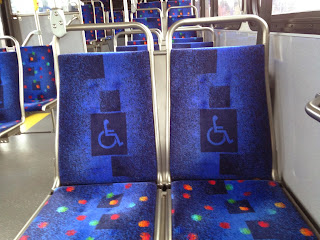By Lucinda Shannon
Sometimes it is hard for transit personnel to persuade passengers to yield their seats for people with disabilities and older adults, especially on a busy route. To ensure accessibility and compliance with the Americans with Disabilities Act, all fixed-route vehicles must have designated seats for people with disabilities and older adults[1], though the operator cannot require a person with a disability or older adult to sit in that area[2]. Operators are required to request that passengers vacate priority seats if the seats are needed. They cannot, however, force a person to move from his seat. In addition to posting signs and holding driver trainings, some transit agencies are developing creative solutions to encourage passengers to yield their seats.
 |
| Screenshot from The Muni Mash |
The Muni Mash (full length, three minutes)
The Muni Mash (short version, two minutes)
 |
| Priority seating on an LTD bus |
- - -
[1] 49 CFR 38.27: “(a) Each vehicle shall contain sign(s) which indicate that seats in the front of the vehicle are priority seats for persons with disabilities, and that other passengers should make such seats available to those who wish to use them. At least one set of forward-facing seats shall be so designated. (b) Each securement location shall have a sign designating it as such.”
[2] 49 CFR 37.5(c): “An entity shall not require an individual with a disability to use designated priority seats, if the individual does not choose to use these seats.”

No comments:
Post a Comment